Beef Stout Stroganoff
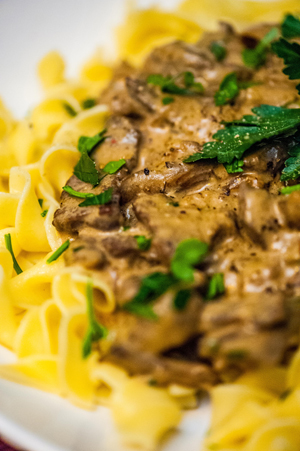 Thinking back on flavors from my childhood, I wanted to rediscover stroganoff: Tender, succulent beef, earthy umami-rich mushrooms, and sweet caramelized onions, all enveloped in a rich, slightly sour creamy sauce. Take all these ingredients and pour it over egg noodles or another starch | grain | pasta. How could I re-create this classic dish while elevating it with beer creating—dare I say—the ultimate beef stroganoff recipe? Even a Beef Stout Stroganoff recipe?
Thinking back on flavors from my childhood, I wanted to rediscover stroganoff: Tender, succulent beef, earthy umami-rich mushrooms, and sweet caramelized onions, all enveloped in a rich, slightly sour creamy sauce. Take all these ingredients and pour it over egg noodles or another starch | grain | pasta. How could I re-create this classic dish while elevating it with beer creating—dare I say—the ultimate beef stroganoff recipe? Even a Beef Stout Stroganoff recipe?
The beef used for stroganoff is all over the map. Many recipes suggest tenderloin, the expensive, underused muscle that is tender and velvety. The results are wonderful, yet cause the price of this dish to skyrocket. Other chefs like to use a chuck or sirloin cut, which can be tough, chewy, and unsatisfying if overcooked. But what if we add a step?
The Japanese use a mold called koji (Aspergillus oryzae) to make miso, soy sauce, sake, rice vinegar, and shio-koji, along with many other items. Shio-koji begins with cooked rice that has been inoculated with koji spores, then left to gather mold. This mold has a living enzyme that breaks down starches and proteins into sugars and amino acids, making the final foods easier to digest. Just the mold spores are available HERE if you want to start at the very beginning of the project
How To Make Shio Koji:
To make shio-koji, start with a mold inoculated rice. This item can be purchased at some gourmet markets, sometimes found in the refrigerated bulk section of a health food store, Japanese food market, or online HERE. Heat 2 cups or 475 grams of water to 140°F | 60°C in a pot, on your stovetop. Add 9 tablespoon of sea salt (120 grams). I suggest using pure sea salt that is not overly processed. I want all the minerals, crystals, and colors that I can get from the salt. I use a French Grey Sea Salt
. Blend together well, until the salt is fully dissolved. Let the saltwater cool to 100°F | 39°C and stir in 550 grams of koji rice. Once the rice has re-hydrated, transfer the entire mixture to a 1/2 gallon mason jar and cover loosely with a lid. Let this mixture sit out at room temperature for 7 – 10 days. Depending on what your room temperature is, this process will speed up in a warmer room, while taking longer in a cooler room. The finished shio-koji will be thicker than when you started as the rice will have broken down by the spores and fermented. Most of the sugar and starch will be been consumed, resulting in a sweet aroma with notes of fruit and some funk. Seal the container and place it into the refrigerator for up to a year. This shio-koji mother can be used as a marinade, in a brine, rubbed on meat | seafood | vegetables | and used to create all kinds of new recipes.
Shio-koji can also be purchased already made HERE.
Using shio-koji as a marinade for the beef tenderizes the meat protein, increasing the umami factor. By applying this fermentation trick, we can use a cheaper cut of meat. And preparing this step a few days ahead of time makes it even easier to assemble the stroganoff. One can use a higher grade of beef, such as hanger steak or tenderloin, and bypass this marination process, or make it with it.
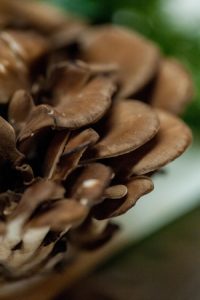 An Oatmeal Stout contributes a roasty, earthy element to the sauce (that’s full of umami-rich mushrooms), while also adding a touch of astringency balanced by the sweetness of caramelized onions and garlic. This is great cooking with beer, beer, as it is low in hop bitterness, malty and good ratio of flavors. Plus, what would a Beef Stout Stroganoff be without stout beer?
An Oatmeal Stout contributes a roasty, earthy element to the sauce (that’s full of umami-rich mushrooms), while also adding a touch of astringency balanced by the sweetness of caramelized onions and garlic. This is great cooking with beer, beer, as it is low in hop bitterness, malty and good ratio of flavors. Plus, what would a Beef Stout Stroganoff be without stout beer?
Meanwhile, the rich and fatty sour cream sauce tames any astringency from the roasted grains used in this beer style. I prefer maitake or Hen of the Woods mushrooms, which bring great texture and meaty flavor to the dish. A mix of mushrooms such as chanterelles, wood ear, shiitake, and crimini, can also add texture and earthy deliciousness.
These recipe tweaks infuse the finished stroganoff with layers of scrumptious flavor and texture, yielding a balanced yet complex version of a nostalgic comfort dish.
Adapted from BeerAdvocate Magazine: Cuisine à la Bière | Jun 2018 | Issue #132

| Servings | Prep Time |
| 4 people | 15 minute |
| Cook Time | Passive Time |
| 20 minute | 24-72 hour |
|
|

|
This recipe uses shio-koji and Oatmeal Stout to tenderize and flavor this Beef Stout Stroganoff. Mushrooms, sour cream, caramelized onions combine to make a delicious sauce to go over noodles or other starch.
|
- 2 tablespoon Oatmeal Stout, such as Anderson Valley Barney Flats Oatmeal Stout
- 1 tablespoon Shio Koji made from scratch, available at most Asian markets or online
- 1 tablespoon salt, kosher
- 1 tablespoon thyme dried or double if using fresh
- 1 teaspoon peppercorns, mixed freshly cracked
- 1 pound top sirloin, or hanger steak, cut into stir-fry strips
- 3 tablespoon olive oil
- 1 each onion, yellow, large, peeled and sliced
- 1 each shallot large, peeled and sliced
- 1 pound mushrooms, such as maitake, crimini, Portobello, or shiitake, or a mixture of
- 1 tablespoon miso, white
- 1 teaspoon salt, kosher
- 1 teaspoon soy sauce
- 10 ounce Oatmeal Stout, such as Anderson Valley Barney Flats Oatmeal Stout
- 1 cup sour cream | Mexican crème | crème fraîche full fat
- 3 tablespoon parsley, Italian leaf (and/or chives) washed, chopped plus more for garnish
- 1 pound noodles | pasta such as (wide egg | pappardelle, | ramen) or gnocchi
- or
- 2 pound mash potatoes
- or
- 4 cup pearl barley cooked
- parsley, Italian leaf (and/or chives) washed, chopped
- In a bowl, combine the Stout, shio-koji, salt, thyme, and cracked peppercorns. Slice the beef into 1 inch long strips, as uniformly as possible (helping them to cook at the same rate). Add the meat to the shio-koji and toss to fully coat the surface area of the protein.
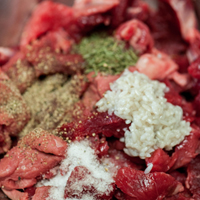
- Place into a sealable container and marinate in the refrigerator for 24–72 hours, allowing the enzymes in the shio-koji to break down the proteins, resulting in increased umami and tenderness.
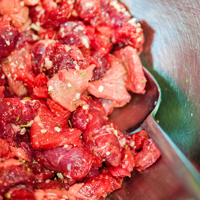
- About two hours before serving, remove the marinated meat from the refrigerator, letting it warm to room temperature on the kitchen countertop. This will help the beef cook quicker and more evenly.
- Pick out your complementing starch. If it’s pasta, fill a large pot with water, salt to taste, and place over high heat.
- In a wide sauté pan or Dutch oven over medium heat, add 2 tablespoons of oil, tilting the pan to evenly coat the bottom. Add the sliced onion and lightly season it with some of the salt. Sauté the onion, stirring frequently until transparent, about 7 minutes. Add the shallot to the onion and sauté for another 7 minutes.
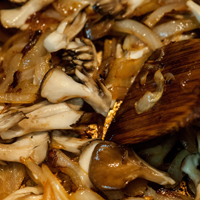
- Use this time to clean, de-stem, and slice the mushrooms. Add them to the pan, along with the remaining salt, continuing to cook the onions and shallots for another 6 – 7 minutes. The edges of the mushrooms should be brown. This slower cooking technique will evaporate moisture, concentrating the flavors and caramelizing the sugars in the vegetables to lend extra depth to the sauce. Add the miso, breaking it up with a spatula. Cook for another minute.
- Increase the heat to high and pour in the soy sauce. Stir well to coat all the ingredients while reducing to a glaze, then deglaze the pan with the Oatmeal Stout. Then, using a spatula, scrape all the fond from the pan, dissolving it into the sauce. Reduce the Stout by half, cooking for 4 – 5 minutes. If you aren’t serving the sauce right away, turn the heat off to avoid overcooking the meat.
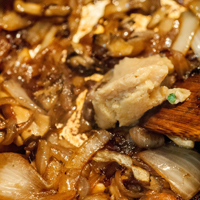
- Move all the ingredients to one side of the pan. Add the remaining oil and then the meat and marinade to the open space in the pan. Let it cook for 2 minutes, caramelizing. Carefully stir the onions to prevent them from burning.
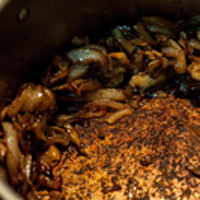
- Stir the steak and allow it to brown on its other side for 2 – 4 additional minutes, searing the outside. Start cooking the starch or have it ready at this point.

- Increase the heat to high and pour in the soy sauce.

- Stir well to coat all the ingredients while reducing to a glaze, then deglaze the pan with the Oatmeal Stout. Then, using a spatula, scrape all the fond from the pan, dissolving it into the sauce. Reduce the Stout by half, cooking for 4 – 5 minutes. If you aren’t serving the sauce right away, turn the heat off to avoid overcooking the meat.

- With the heat off, add the sour cream | Mexican crème | crème fraîche to the Stout reduction. Cooking the sour cream can cause the sauce to break or curdle. Check the consistency of the sauce—it should be thick, but not too thick. If needed, thin the sauce with a tablespoon of sour cream | Mexican crème | crème fraîche or Stout. Stir in 2 tablespoons of chopped parsley (or chives) and a few cracks of fresh peppercorns. Add salt to taste.
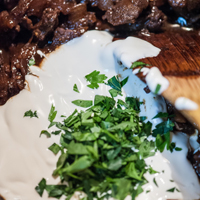
- If using pasta, toss the noodles in a few tablespoons of butter and the remaining tablespoon of parsley. Place a healthy portion onto each plate, then ladle the rich stroganoff sauce over the starch.
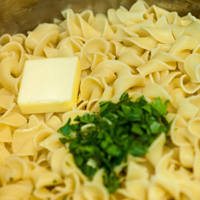
- Garnish with a few sprigs of parsley or chopped chives and serve right away.
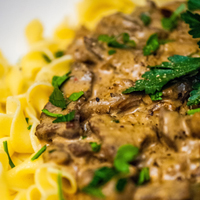
More Koji Recipes Here:




